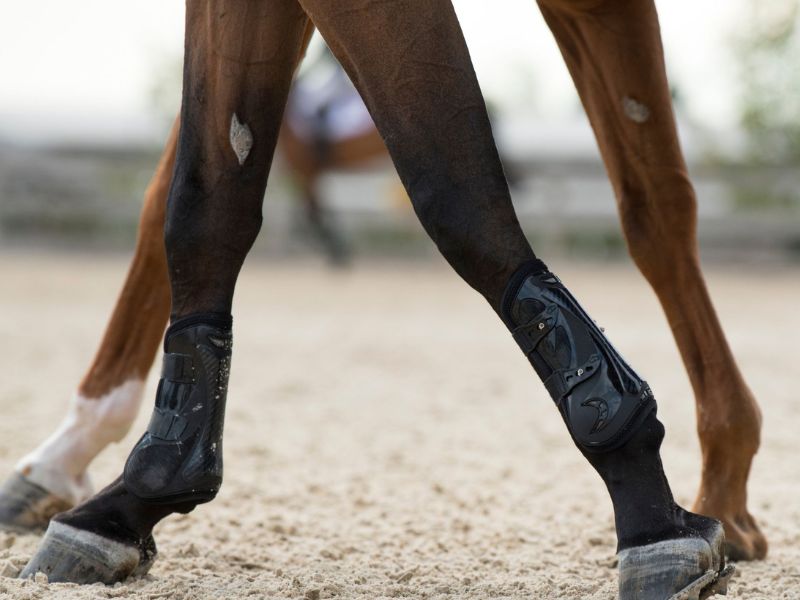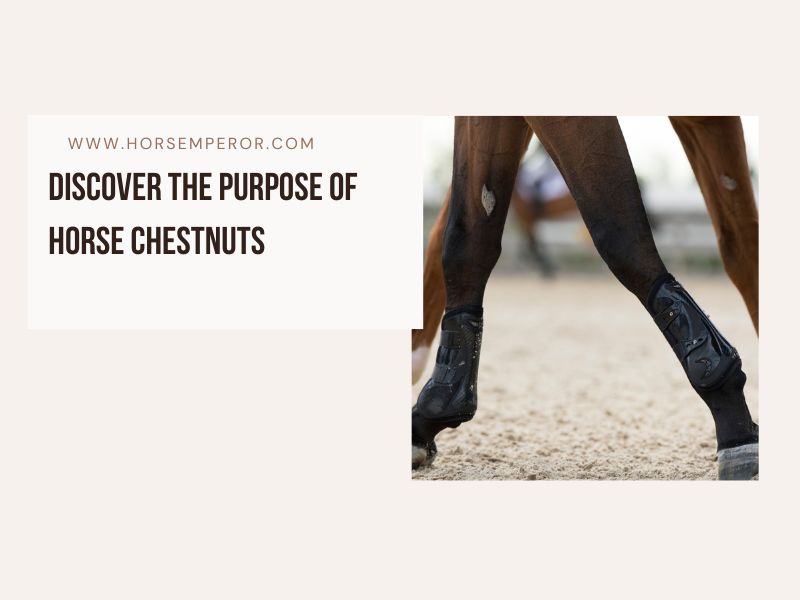A chestnut is a callused patch or a prickly bump that appears near the fetlock or just above the ankle. You can feel this dry, rough area when you run your hand along the inside of a horse’s leg. It’s not a nut or a coat color—it’s one of the odd features of equine anatomy.
A chestnut is a hardened structure made of keratinized skin, found on the inner side of the horse’s foreleg (above the knee). In many cases, it’s also found below the hock on the hind leg. Some breeds have chestnuts on all four limbs, but breeds like the Icelandic horse may be missing them on the back legs.
Chestnuts are thought to be vestigial toes—remnants from a time when horses had multiple toes, just like dogs or even people. As horses evolved, they traded these extra digits for a single toe that gave them greater speed and stability.
It’s amazing to see how such a small mark carries visible evidence of the horse’s evolutionary past. However, paleontologist Darren Naish argues that chestnuts don’t align with the bones (metacarpus, metatarsus) where digits usually form.
What Is a Chestnut on a Horse?
Definition & Appearance
A chestnut is a dry, callous-like growth that appears on the forelimbs, just above the carpus (knee). These horn-like patches of keratinized skin are also found on the hindlimbs, just below the hock, near the fetlock. These marks are similar to a scab and are not painful or harmful.

Every horse has unique chestnuts, just like fingerprints in humans. The shape, size, and thickness of a chestnut can be different for every horse depending on breed, environment, and genetics. Breeds like the Icelandic horse, Caspian pony, or Banker horse usually have different chestnut patterns.
Anatomical Composition
The chestnut is made of keratin, the same protein found in a horse’s hooves, fingernails, and hair. It comes from thickened epithelial structures in the dermis. But unlike other skin areas, the chestnut does not have any blood supply or nerve endings.
It grows slowly over time and naturally sheds in layers. It doesn’t cause any discomfort or problems unless it’s affected by a bacterial infection or inflammation.
Historical & Evolutionary Context
Many experts believe that chestnuts are vestigial remnants of old toe pads. These are considered leftovers from the horse’s distant ancestors, like the dawn horse (Eohippus). Horses once had multiple toes, which helped them move through dense forests.
In fact, W. Bodmer conducted research in 1930 on the origins of chestnuts across ungulates. He compared the callous-like wrist pads in horses to similar structures in other mammals and concluded that chestnuts are likely tactile organs or evolved callouses.
Over time, they evolved to a single-toed hoof for better speed and limb positioning. Chestnuts and ergots are what’s left from that earlier structure. Most evolutionary biology experts agree that they no longer serve a clear biomechanical function today. But older theories suggested that chestnuts were scent glands, sensory structures, or part of a wrist pad.
Chestnut vs. Other Foot Structures
Chestnut vs. Ergot
Chestnuts and ergots are both made from keratin, but their size and location are different. Ergots are smaller, rounder, and found near the back of the fetlock, often hidden under hair.
Chestnuts, on the other hand, are more visible and appear higher on the legs. Both are vestigial structures, but chestnuts are more commonly found in horse breeds.
Chestnut vs. Frog, Heel Bulbs, Openings
It’s important to understand that chestnuts are different from other parts of the hoof like the frog, heel bulbs, or hoof openings. These other structures help with shock absorption, traction, and blood circulation.
Chestnuts are not connected to hoof function or involved in movement or weight-bearing. Understanding these anatomical structures helps with better hoof care and grooming.
| Aspect | Chestnut | Ergot | Frog, Heel Bulbs, Openings |
|---|---|---|---|
| Location | Inside forelimb above the knee; below hock on hind legs | Underside of fetlock, often hidden under hair | Bottom of hoof—central frog, heel bulbs, and sole openings |
| Size & Shape | Variable: oval, bean-shaped, or irregular; unique per horse | Smaller, round, pea-like; fairly consistent | V-shaped frog; smooth bulbs; variable based on hoof anatomy |
| Composition | Hard keratinized growth, no nerves/blood vessels | Keratinized tissue under fetlock, connected to ergot ligament | Living tissues with blood supply and nerve endings—essential for hoof health |
| Evolutionary Role | Vestigial remnant of extra toes or scent gland; variable consensus | Vestigial sole pad; possibly aids water drainage | Fully functional: absorb shock, circulate blood, provide traction |
| Current Function | No biomechanical role; used for breed ID and evolutionary insight | No essential function; speculated to guide water from fetlock region | Critical for hoof function and horse mobility |
| Care Considerations | Trim loose keratin carefully; monitor for cracks/infection | Trim if overgrown or interfering with boots; avoid ligament damage | Requires regular trimming/reshoeing, cleaning to prevent rot |
Do Chestnuts Serve Any Purpose?
Chestnuts don’t serve a modern-day function, but they have evolutionary significance. They are simply evolutionary remnants from earlier species development. Some theories suggest they may store scent or act as friction pads, but these are not proven.
Researchers like Sharon May-Davis agree that chestnuts are generally non-functional, but they help with identification and tracking genetic diversity.
Variations in Chestnuts
Differences by Horse & Breed
Chestnuts can vary from horse to horse. Their shape, symmetry, and how much they shed can differ by breed. For example, a Thoroughbred may have smoother, flatter chestnuts, while a mule, donkey, or even a zebra might have irregular ones.
These differences reflect breed-specific traits, genetic indicators, and physical variation within the global horse population.
Age-Related Changes
Young horses are born with small, soft chestnuts that become keratinized as they grow. Over time, these growths naturally shed, and regular monitoring helps catch anything unusual.
This supports good equine health and helps prevent problems like hoof infections or a hoof abscess.
Caring for a Horse’s Chestnuts
Normal Weight & Appearance vs Overgrowth
Normally, chestnuts are dry and flat and don’t grow too much. But if they become large or start cracking, it’s important to groom or trim these overgrowths.
Chestnuts rarely cause hoof-related diseases, but in wet conditions where moisture and sweat collect, they can increase the risk of infection.

When and How to Trim
Chestnuts don’t need frequent trimming. But during grooming, you can use a hoof knife, rasp, or sterilized tool to gently remove loose pieces.
Using baby oil or warm water can soften the area, making it easier. However, always be careful not to damage healthy tissue.
What Not to Do
Avoid over-trimming. While chestnuts don’t bleed, cutting too deep can cause pain, inflammation, or infection. It’s best to consult a veterinarian or farrier if you’re unsure.
Signs of Problems
Monitor your horse regularly. Look for signs like cracks, swelling, white line disease, thrush, or any discharge.
These symptoms may point to serious hoof diseases or skin issues. Early detection and proper horse management are important for maintaining animal welfare.
Common Myths & Misconceptions
Some horse owners believe that removing chestnuts improves the horse’s performance. But that’s not true—they are harmless and have nothing to do with performance or health.
Some also believe chestnuts are a sign of disease or that removing them affects a horse’s ability, which is also false. Chestnuts are only trimmed for cosmetic or grooming reasons.
When to Contact a Vet
It’s important to contact a veterinarian if you notice that a chestnut is swollen, hot to the touch, or leaking fluid. These may be signs of infection or another issue.
Regular monitoring and proper care help support your horse’s hoof health and overall wellbeing.
Conclusion
A chestnut is a small, harmless mark that tells the story of the horse’s evolution and its ancient ancestors. It doesn’t affect performance or health but plays an important role in horse anatomy and identification. While chestnuts are harmless, they still require proper grooming and care.
Trim chestnuts only when needed. Keep them clean and stay alert for any changes. Contact a veterinarian if you notice signs of disease.
